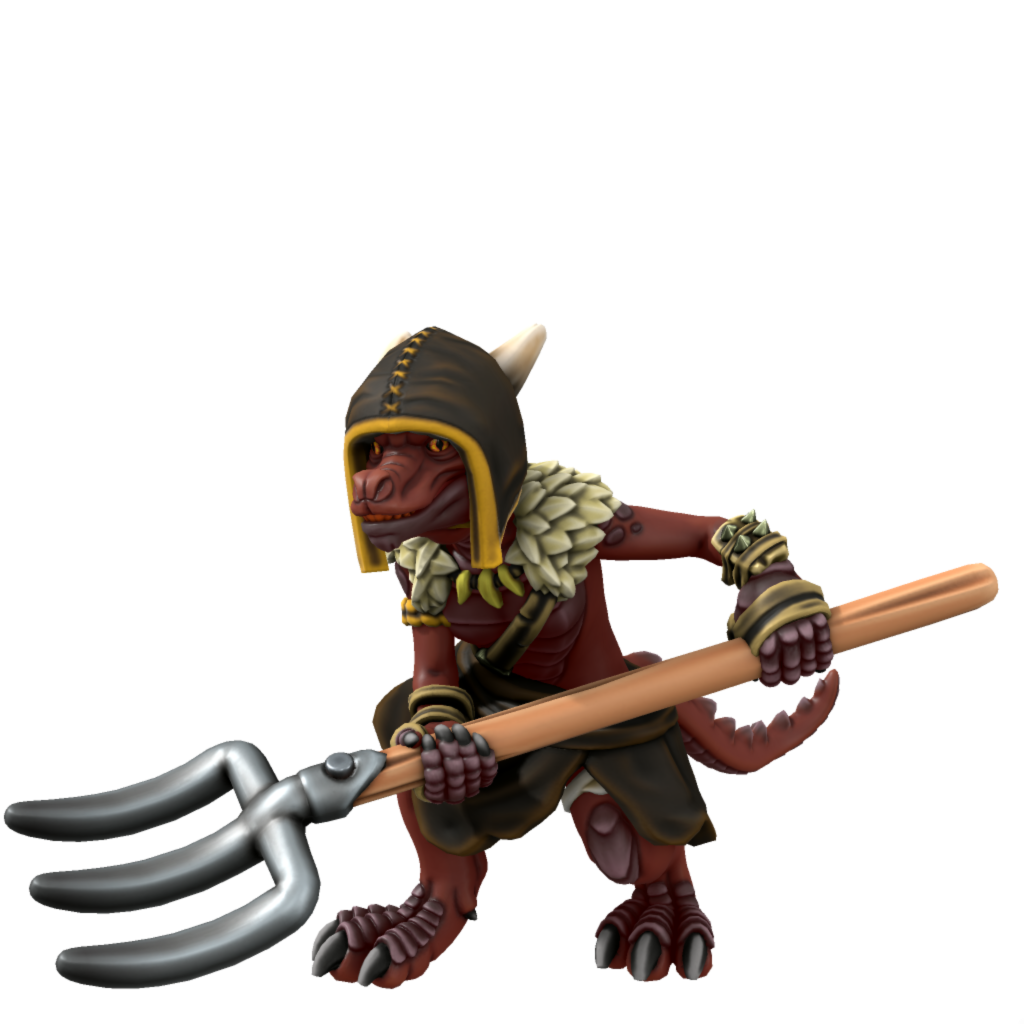Kobold
Kobolds may be distantly related to dragons, they speak a version of the Draconic tongue, with a yipping accent. They have features that are both reptilian and doglike.
Kobold societies can be vastly different, but the information here covers the most common kobold traits and commonalities.
Males are about three inches taller and ten pounds heavier than most females.
Basic Information
Anatomy
Kobolds are small humanoids with scaly, hairless hides, reptilian faces, and tails. Their heads are dog-like in shape, but scale covered like the rest of their bodies.
Biological Traits
Their hides are typically a rust-brown or reddish black color, with ivory-colored horns. Their eyes are keen and glow red or yellow in the darkness. Kobolds are described as smelling like a cross between damp dogs and stagnant water. Even cleaned up they have a vaguely unpleasant aroma. Unlike dragons , kobolds are cold-blooded. The scales covering their bodies are like that of an iguana or other large lizard. The scales that cover their tails are very fine, so that they resemble the naked tails of rats. Kobolds lose and gain new teeth throughout their lives, often saving and making necklaces from them.
Genetics and Reproduction
Kobolds are extremely fecund egg-layers, having the highest birth rate (and death rate) of all humanoid species. A female kobold will lay a clutch of hard-shelled eggs two weeks after fertilization; the eggs must be incubated for an additional 60 days before hatching.
Ecology and Habitats
Kobolds tend to be cave dwellers. They are found in all climates. They seem to prefer dark, damp underground lairs but are also found in overgrown forests. They are industrious miners and if left to their own devices can carve out massive tunnel complexes, which they quickly fill to capacity thanks to their rapid rate of reproduction – which would explain their use as cannon fodder enemies in the armies of larger races.
Many kobold lairs are guarded by boars, giant weasels or other beasts that have been semi-tamed by the kobolds. Their lairs are fluid, with new tunnels continually being excavated and old ones collapsed. Most lairs include a temple or shrine ,a kiln, an egg hatchery, and a place for storing food. Larger ones also contain places for cultivating food and livestock.
Dietary Needs and Habits
Kobolds are omnivores with no scruples about what or whom they eat. They can digest bark, dirt, leather, eggshells, or their own younger siblings if they are desperate enough.
Biological Cycle
Kobolds shed their skin about once a season, in patches, over the course of a week. They keep themselves well-groomed, regularly polishing their horns, claws, and teeth and their odor seems to come from a natural oil secreted by the skin shedding process.
Civilization and Culture
Relationship Ideals
While they do bond with one another, they have no concept of monogamy.
Common Dress Code
Kobolds favor raggedy-looking red or orange clothing made from leather or the silk of Giant Spider. They never wear shoes, but they are fond of jewelry and other ornamentation.
Interspecies Relations and Assumptions
They are often at war with goblins, and the numerous kobold-goblin wars help keep the populations of both races down to a manageable level. Deep gnomes often act as intermediaries and mediators between kobolds and goblins.
Lifespan
Kobolds reach maturity by the age of eight or nine and are considered elderly by the age of 121. They can live up to 135 years but very few do.
Average Height
Kobolds vary in height between 3'6" and 4'0".
Average Weight
Approximately 40 pounds.
Kobold
Ability Score Increase +2 Dex
Size Small
Speed 30 ft.
Kobold Traits
You can see in dim light within 60 feet of you as if it were bright light, and in darkness as if it were dim light. You can't discern color in darkness, only shades of gray. Grovel, Cower, and Beg
As an action on your turn, you can cower pathetically to distract nearby foes. Until the end of your next turn, your allies gain advantage on attack rolls against enemies within 10 feet of you that can see you. Once you use this trait, you can't use it again until you finish a short or long rest. Pack Tactics
You have advantage on an attack roll against a creature if at least one of your allies is within 5 feet of the creature and the ally isn't incapacitated. Sunlight Sensitivity
You have disadvantage on attack rolls and on Wisdom(Perception) checks that rely on sight when you, the target of your attack, or whatever you are trying to perceive is in direct sunlight.
Languages. You can speak, read, and write Common and Draconic.




Comments